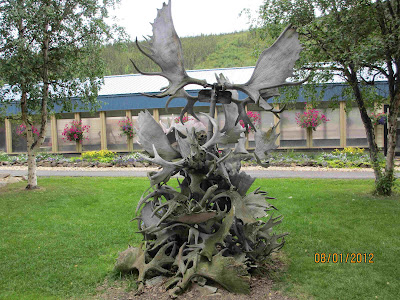We prefer to camp at isolated state and provincial parks in Alaska and Canada, rather than at commercial campgrounds on the main highways. They are usually in beautiful areas and are much more private and rustic. They are usually on lakes or rivers and have hiking trails. We like to go to a commercial campground occasionally to catch up on the internet and do our laundry. That is where we are now -- at the Rotary RV Park in Ft. St. John's in British Columbia -- and where we are sending this blog post from. Another big difference between public and private campgrounds is the price. The public ones are usually $10-$20 per night while the private ones are $25-$45.
Below is a picture of the commercial campground we are camping in now here in British Columbia. Notice the beautiful setting. As you can see, it is flat and treeless, with each site very close to your neighbor. They do have laundromats, showers, free WiFi and cable TV hook-ups. Since we don't carry a TV with us, this is not a high priority. They also often have meeting rooms with big screen TVs, kitchens, activities, etc. We actually have watched a little bit of Olympic coverage at the Chena Hot Springs campground north of Fairbanks.
Rotary RV Park in Ft.St.John, British Columbia
Now . . . below is a picture of Rita at a state park on the Cooper River in the Kenai Peninsula in southern Alaska. You can see how nice the site is but they have no facilities except a water pump and an outhouse. Bill backs the trailer in and we are all set in our own little space. Sally is learning to back, but Bill gets pretty nervous watching and trying to offer instructions which, of course, makes Sally more nervous!
The only big drawback with state and provincial parks is the water supply, which is usually a hand pump. Some of the water has been fine, but often it is not so great. If it looks awful and has a sign saying to boil it, we use our store-bought water.
We both take turns pumping.
Bill is still holding the bucket, waiting for the water.
This sounds pretty bad, doesn't it.

We decided to dump this out. It was not a candidate for boiling!
![[453.JPG]](https://blogger.googleusercontent.com/img/b/R29vZ2xl/AVvXsEjaDgZCN6LafWJoCQTscFh-nDAHvOEIQ1CCZZYwZk2-_nCxc8LkLXJ9t2RLXq5wC5dYswkY3-vKOyzyxhSDi-Z5ygiav7CGY_hz7YWZHijLd0pUQtt5jaTe3TvsqhNwlzhN3K4HLOmq3f8/s220/453.JPG)
















































